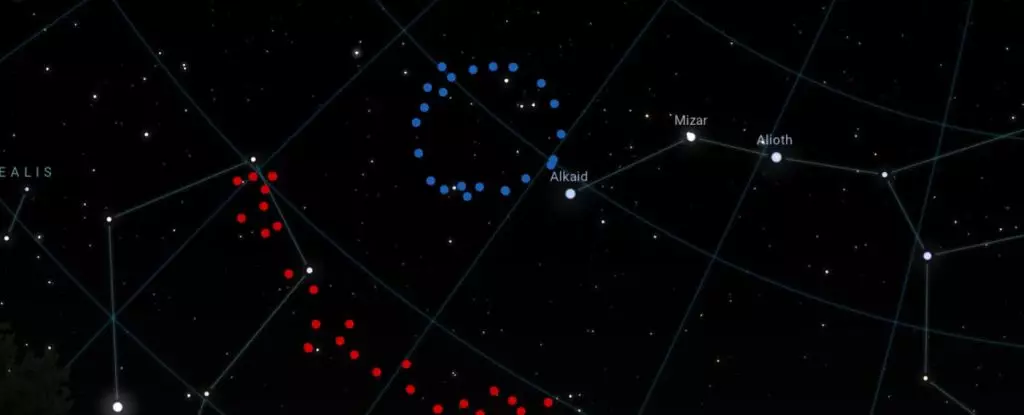In an unprecedented revelation, astronomers have unveiled a colossal and perplexing formation in the cosmos that may require a fundamental rethinking of our current understanding of the Universe. Dubbed the “Big Ring,” this striking structure comprises an enormous arrangement of galaxies spread across a staggering circumference of approximately 1.3 billion light-years. This discovery, led by Alexia Lopez from the University of Central Lancashire and presented at the 243rd American Astronomical Society meeting, has ignited a wave of intrigue and speculation within the scientific community.
The Big Ring is not just another cosmic curiosity; it presents a conundrum that defies the conventional structures recognized in modern cosmology. Light from this grandeur has journeyed across the fabric of time for 6.9 billion years before reaching Earth, giving astronomers a glimpse into a bygone era. Yet, its existence throws into question the very nature of cosmic evolution as we understand it. This revelation beckons scientists to delve deeper, pushing the boundaries of theoretical models that have long been considered robust.
A Cosmic Puzzle: The Nature of Large-Scale Structures
At present, structures of this magnitude are thought to be constrained by the Cosmological Principle, which posits that the distribution of matter in the Universe should be homogenized when viewed at a grand scale. Lopez emphasizes this expectation, noting that theoretical calculations suggest a size limit for cosmic structures at around 1.2 billion light-years. The intense sizes of both the Big Ring and its predecessor, the Giant Arc, which is nearly three times larger, challenge this very principle.
The discovery of the Big Ring and the Giant Arc amplifies the urgency for cosmologists to address the discrepancies between observational data and established models. Supposedly, giant structures formed by Baryon Acoustic Oscillations (BAOs) — remnants of sound waves propagating through the early Universe — are limited in their size to about a billion light-years. The Big Ring, however, does not conform to this principle as it reveals a corkscrew-like structure rather than the expected spherical arrangement associated with BAOs. This striking deviation begs the question: what lies at the heart of these cosmic phenomena?
Charting New Territory: Theories and Implications
As astronomers grapple with the implications of such colossal formations, several theories emerge, vying for attention. One prominent contender is Roger Penrose’s Conformal Cyclic Cosmology, which posits that the Universe undergoes infinite cycles of expansion and retraction. Although this approach provides a theoretical framework for explaining such structures, it also presents its own set of challenges that raise questions about its validity.
An alternative theory suggests that the Big Ring may be a manifestation of cosmic strings—topological defects in the fabric of space-time. These hypothesized entities may represent remnants from the early Universe, akin to frozen wrinkles that emerged during the rapid expansion following the Big Bang. While evidence for cosmic strings remains scarce, the theoretical groundwork supporting their existence opens a window for understanding these colossal phenomena.
However, the notion that the Big Ring and the Giant Arc could simply be incidental alignments of galaxies cannot be entirely dismissed. The possibility of these arrangements being mere coincidences seems improbable when one considers their staggering sizes and regularities. The statistical likelihood of them occurring purely by chance casts doubt on our ability to reduce these structures to randomized cosmic events.
The Quest for a Broader Understanding
As cosmic explorers push forward in their investigation of the Big Ring, one compelling strategy is to expand the search for additional structures of comparable size and complexity in the Universe. These grand formations might be mere fractions of a more significant pattern that remains unseen. Discovering more of these galaxy assemblages could play a pivotal role in reshaping cosmic narratives and enhancing our understanding of the Universe’s architecture.
Despite Lopez’s cautious tone regarding the future of cosmological theories, there lies an undercurrent of excitement among researchers. The Big Ring stands as a testament to the mysteries that still await discovery amidst the vast, unfathomable expanse of the Universe. Each finding promises to unravel more of the cosmic tapestry, inviting scholars to reassess age-old theories and carve paths toward innovative explanations of a dynamic and evolving cosmos.
In a narrative that continually evolves, the Big Ring has begun to etch its name in the annals of astronomical history, signaling a pivotal moment for cosmology. As we calibrate our telescopes toward the skies, we do so with an anticipation for knowledge that may redefine our vision of the Universe—provoking questions only the cosmos can truly answer.


Leave a Reply